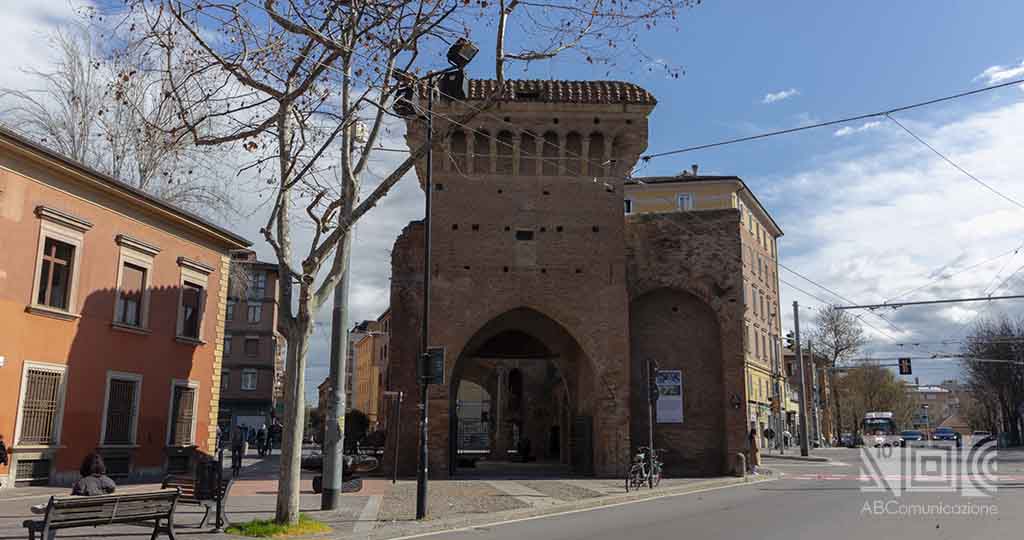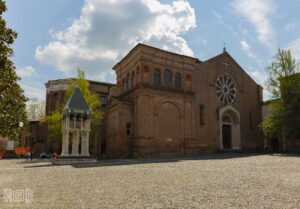Do you want to know the history and curiosities about the walls of Bologna? Come with us to discover the ancient city walls!
Why are the walls built?
It is believed that the first defensive walls of Bologna were built by the Etruscans, with the aim of protecting the city from the frequent barbarian invasions of the time. Following the archaeological excavations, in fact, were found the remains of palisades and galleries with raised passages dating back to the VII century (601 – 700 b.C).
Although it is very likely that ancient Bononia was already equipped with ditches and defensive systems, to date there are no traces that can indicate their existence.
The walls of Bologna, therefore, were created with the intention of defending the city and, from the first enclosure that once distinguished the city “inside the walls”, more walls have developed as a result of demographic expansion.
Following the demolition of the Circla in the XX century, it is currently possible to see only some remains of the original walls and the famous gates that allowed access to the city.
Discover with us the three main walls of Bologna: the Circle of Selenite, the Circle of the Thousand and the Circla.
In Bologna there were also walls inside the walls. In fact, in the heart of the city, a few steps from the Two Towers, there is the ancient Jewish ghetto. This has known a long history of isolation and segregation, precisely through the construction of walls, which marked its perimeter, preventing the inhabitants of the neighborhood from moving freely. Discover all its history in our article The ancient Jewish ghetto of Bologna: a journey through it.

The Circle of Selenite
The first wall is called the Selenite Circle, taking its name from the material with which it was built. In fact, selenite is a chalky, orange-colored mineral, present in large quantities on the Bolognese hills.
The Circle of Selenite is the oldest city walls in Bologna, built following the barbarian invasions in correspondence with the decline of the Western Roman Empire. The city of that period is in fact described as “semi-destroyed”, making it necessary to build defensive systems capable of protecting the inhabitants and the territory. Their construction was hasty due to the urgency of the danger that loomed over the city. This reason could be the explanation why the walls were dry superimposed, without foundations and for their narrow perimeter, which included about a third of the actual inhabited area.
A curiosity about this circle concerns its construction through the “re-use” method. In fact, some previous Roman buildings were destroyed and their material was used to create the walls.

The seat of the bishop and the imperial power was located within the Circle of Selenite, while the rest of the city was abandoned taking the name of “civitas antique rupta”, as if it were a Roman ruin.
The Quadrilatero of Bologna
The Circle of Selenite formed a sort of quadrilateral with two doors that connected the inside of the walls to the outside. The first is Porta Ravegnana, which connected the city to Ravenna (currently located in St. Emilia). The second is Porta Stiera, located in connection with Modena. Later two other doors were added, Porta San Cassiano and Porta San Procolo. Currently, this area corresponds to the so-called Quadrilatero.
Near Porta Ravegnana, in addition to the Two Towers, you can also discover one of the Seven Secrets of Bologna: The Fountain of Neptune. In addition, in the Quadrilatero area you can stop to eat in many typical taverns of Bologna, Discover some with us in the article Pasta Fresca in Bologna: the art of bolognese grannies.
The four cross
Furthermore, between the IV and V centuries a.d., the so-called “four crosses” were added, commissioned by Sant’Ambrogio, in correspondence with the four cardinal points (and the four doors). These crosses survived the time, but were later removed in 1796, as a detachment from religion in order to make the streets “laic”. Today they are kept in the Basilica of San Petronio: let’s find out together in the article All you need to know about the Basilica of San Petronio in Bologna.
Currently, you can see the remains of the Selenite Circle at the Medieval Civic Museum in Palazzo Fava, in St. Manzoni 2.
In 1163, the emperor Federico Barbarossa gave the order to destroy the walls, leaving the city without the possibility of defense against his troops: his goal was, in fact, to conquer all of northern Italy.
Barbarossa’s directives were only partially respected, saving some pieces of the walls. Furthermore, after the victory of the citizens, it was decided to start the construction of a new city wall.
Currently, you can see the remains of the Selenite Circle at the Medieval Civic Museum in Palazzo Fava, in Via Manzoni 2.
Another must-see museum is the one on the Basilica of Santo Stefano, a place rich in history and legends behind its construction. Get to know all the other museums that the city offers: there are some designed for children! Did you know that the Basilica of Santo Stefano houses one of the most interesting and beautiful crypts in the city?
The Circle of the Thousand
Also known as the “Cerchia dei Torresotti”, the Circle of the Thousand is the second city wall built in Bologna. Unlike the Circle of Selenite, the Circle of the Thousand had a round shape and, in correspondence with the doors, there were small turrets.
Dating back to the year 1000, the Circle of the Thousand was built following the expansion of the city with the simple purpose of controlling the entrances and exits from the center. The years of the invasions had, in fact, ended for this reason the Circle of the Thousand was not composed of particularly robust walls.

In addition, the construction of these new city walls made it possible to incorporate some villages that were outside the first circle into the urban space. In this way, greater protection could also be guaranteed for these areas, in which the population expansion was gradually increasing.
The wall had 18 gates; today there are only four: Porta San Vitale, Porta Govese (in St. Piella), Torresotto di Porta Nova and Torresotto di Strada Castiglione.
These four gates are still visible in the city and are perfectly incorporated into the urban development of Bologna.
The Circla
The last wall of Bologna is called the Circla.
Its construction dates back to the XIII century (1201 – 1300 a.d.) following the progressive increase of the population and its perimeter encloses both previous circles.
On the reasons for the demographic increase, read also Bologna: the oldest university of the Western world. Did you know that the University of Bologna can also boast of having had the first woman as a university teacher? Come and discover her story.
For the same reasons they also built the arcades of Bologna, including the longest in the world with a length of 3,796 meters that will take you to the Sanctuary of Madonna di San Luca, do not miss it!
Initially, the Circla was built with wood: it was only in 1327 that the sack wall technique began to be applied. This method consists of pouring a mixture of pebbles, sand and brick between the bricks and is still visible in the remains of walls still present today.
The Circla: the biggest wall
The Circla was clearly larger than the other two circles and extended for 7.6 kilometers. In addition, it had 12 gates with drawbridges, which made it possible to overcome the moat that surrounded the city.
This circle of walls involved the use of about 20 million bricks, 40,000 cubic meters of pebbles and an enormous amount of timber: in fact, it took two generations to complete its construction.
Currently, the perimeter of the Circla corresponds to the ring road boulevards of Bologna as with the demolition of the walls the external ditches on which the boulevards of Bologna now stand have been filled. Some remains are still visible following the destruction of the enclosure. A well-preserved example is located near the headquarters of ABComunicazione srl in boulevard Antonio Silvani.

If you are interested in deepening these topics, do not miss a visit to the SalaBorsa Library, a place of culture, where you can find all kinds of books. In addition, a curiosity of this library is that it once housed one of the oldest gardens in Europe: The Botanical Garden.
Why were the walls destroyed?
At the beginning of the 20th century, following the decision of the Municipality to put into practice the innovative contents of the first regulatory plan of Bologna in 1889, the demolition of the walls of the Circla of Bologna began.
This decision was “justified” by compelling health reasons. Due to the state of decadence of the walls of Bologna, it was argued that the dismantling would restore decorum and healthiness to the city.
In reality, what really influenced this choice were economic and social reasons. The stalemate in construction had led to the unemployment of many masons, who saw the destruction of the walls as a job opportunity.
In addition, with the demolition of the walls, the municipality was able to make the surrounding land buildable, which was later bought to build villas and houses.

The demolition caused much controversy and the city was divided between the “conservatives” (including Alfonso Rubbiani), opposed to the demolition of the walls and the “modernists” in favor.
The project went ahead in spite of the contrasts and, in place of the fourteenth-century walls, the ring-road avenues began to be created, still viable today.
The original plan also provided for the demolition of the doors, but, thanks to the intervention of Rubbiani and Giosuè Carducci, who testified to their historical and artistic value, they were saved (with the exception of Porta San Mamolo and Porta Sant’Isaia). Even Porta Maggiore, now considered one of the most important, had to be destroyed, but following the discovery of remains dating back to 1200, the works were interrupted.
If you are curious to discover some stories and legends related to religion, we recommend you visit The Cathedral of San Pietro, the Cathedral of Bologna, and San Giovanni in Monte. The latter went from convent to prison until it became one of the University’s headquarters.
The final restoration of the Walls of Bologna
Between 2007 and 2009, the municipality of Bologna implemented a restoration project for the remaining doors: Porta Lame, Porta Galliera, Porta Mascarella, Porta San Donato, Porta San Vitale, Porta Maggiore, Porta Santo Stefano, Porta Castiglione, Porta Saragozza and Porta San Felice. Currently considered as an artistic and cultural heritage of the city, they remain as evidence of the past fourteenth-century wall perimeter.
Did you know that the arcades of Bologna are part of the UNESCO World Heritage? Not only that, Bologna has been named by UNESCO also as Creative City of Music; discover everything there is to know about the musical tradition of Bologna in our article.

Bibliografia
- Bocchi F., Bologna e i suoi supporti, Bologna, Grafis Edizioni, 1997.
- Costa T., Sulle Mura di Bologna, Bologna, Costa Editore, 2000.
- Roversi G., Le mura perdute. Storia e immagini dell’ultima cerchia fortificata di Bologna, Bologna, GRAFIS, 1985.
- Vianelli A., Mura e porte di Bologna, Padova, Tamari Montagna Edizioni, 1976.




